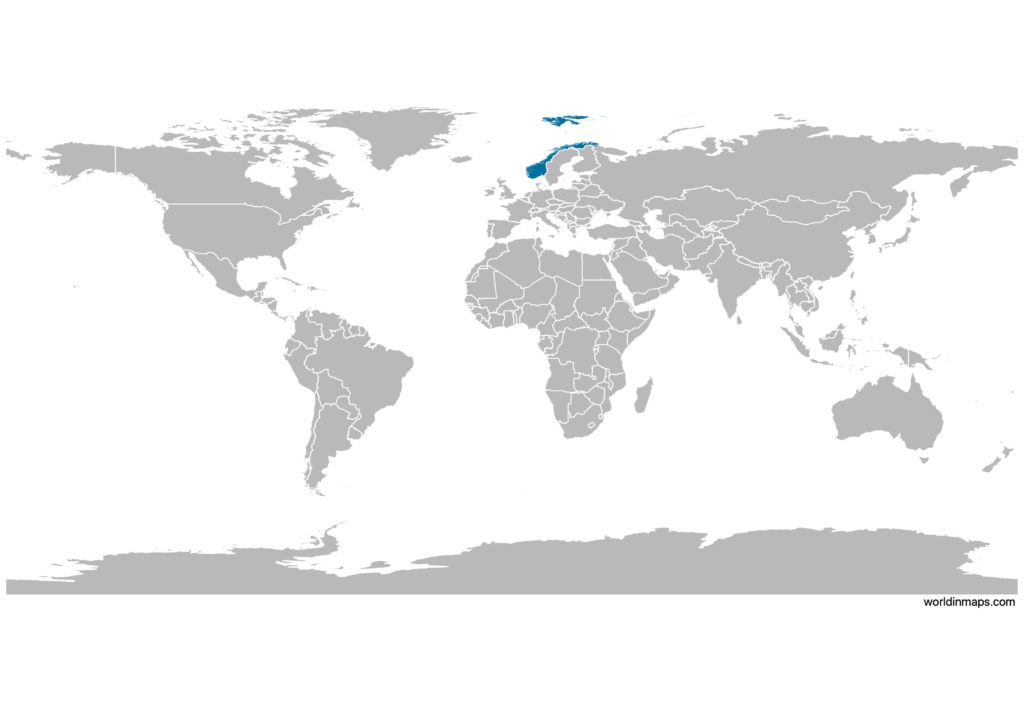Norway

| Government | |
| Name | Kingdom of Norway |
| Bokmal | Kongeriket Norge |
| Nynorsk | Kongeriket Noreg |
| Northern Sami | Norgga gonagasriika |
| Lule Sami | Vuona gånågisrijkka |
| Southern Sami | Nöörjen gånkarijhke |
| Government type | parliamentary constitutional monarchy |
| Capital | Oslo (1,000,467) |
| Currency | Norwegian krone (NOK) |
| People | |
| Population (2020) | 5,421,242 (120th) |
| Density of population | 13.9 P/km2 (213th) |
| Nationality | Norwegian |
| Official languages | |
| Bokmal Norwegian | |
| Nynorsk Norwegian | |
| Sami (dialects: Lule, North Sami, and South Sami) – official language in 9 municipalities in Norway’s three northernmost counties: Finnmark, Nordland, and Troms | |
| Ethnic groups (2017) | |
| Norwegian (includes about 60,000 Sami) | 83.2% |
| other European | 8.3% |
| other | 8.5% |
| Religions (2016) | |
| Church of Norway (Evangelical Lutheran – official) | 70.6% |
| Muslim | 3.2% |
| Roman Catholic | 3% |
| other Christian | 3.7% |
| other | 2.5% |
| unspecified | 17% |
| Life expectancy (2020) | |
| Male | 80 years |
| Female | 84.4 years |
| Total population | 82.1 years (23rd) |
| Homicides | |
| Total (2018) | 0.5 per 100,000 people (165th) |
| Geography | |
| Land area | 304,282 km2 |
| water area | 19,520 km2 |
| total area | 323,802 km2 (69th) |
| Mean elevation | 460 m |
| Lowest point | |
| Norwegian Sea | 0 m |
| Highest point | |
| Galdhopiggen | 2,469 m |
| Land use (2011) | |
| Agricultural land | 2.7% |
| Arable land | 2.2% |
| Permanent crops | 0% |
| Permanent pasture | 0.5% |
| Forest | 27.8% |
| Other | 69.5% |
| Urbanization | |
| Urban population (2020) | 83% |
| Rate of urbanization | 1.4% annual rate of change (2015 – 2020) |
| Economy | |
| Labor force (2017) | 2.797 million (108th) |
| Labor force by occupation (2016) | |
| Agriculture | 2.1% |
| Industry | 19.3% |
| Services | 78.6% |
| Unemployment rate (2017) | 4.2% (56th) |
| GDP (PPP) (estimate 2020) | |
| Total | $397 billion (46th) |
| Per capita | $79,638 (6th) |
| GDP (nominal) (estimate 2018) | |
| Total | $443 billion (22nd) |
| Per capita | $82,711 (3rd) |
| GDP by sector (estimate 2017) | |
| Agriculture | 2.3% |
| Industry | 33.7% |
| Services | 64% |
| Exports (2017) | $102.8 billion (36th) |
| Exports partners (2017) | |
| UK | 21.1% |
| Germany | 15.5% |
| Netherlands | 9.9% |
| Sweden | 6.6% |
| France | 6.4% |
| Belgium | 4.8% |
| Denmark | 4.7% |
| US | 4.6% |
| Imports (2017) | $95.06 billion (36th) |
| Imports partners (2017) | |
| Sweden | 11.4% |
| Germany | 11% |
| China | 9.8% |
| US | 6.8% |
| South Korea | 6.7% |
| Denmark | 5.4% |
| UK | 4.7% |
Norway on the world map

Norway is located in the north of Europe and the mainland is part of the region of Scandinavia.
Norway top 10 largest cities
- Oslo (1,000,467)
- Bergen (255,464)
- Stavanger / Sandnes (222,697)
- Trondheim (183,378)
- Drammen (117,510)
- Fredrikstad / Sarpsborg (112,464)
- Skien / Porsgrunn (93,065)
- Kristiansand (63,441)
- Ålesund (52,625)
- Tønsberg (51,887)
Demography
Population pyramid

Age structure data
Estimate for 2020:
- 0-14 years: 17.96% (male 503,013/female 478,901)
- 15-24 years: 12.02% (male 336,597/female 320,720)
- 25-54 years: 40.75% (male 1,150,762/female 1,077,357)
- 55-64 years: 11.84% (male 328,865/female 318,398)
- 65 years and over: 17.43% (male 442,232/female 510,594)
Remark: the age structure of a population affects a nation’s key socioeconomic issues. Countries with young populations (high percentage under age 15) need to invest more in schools, while countries with older populations (high percentage ages 65 and over) need to invest more in the health sector. The age structure can also be used to help predict potential political issues. For example, the rapid growth of a young adult population unable to find employment can lead to unrest.
Population from 1950 to 2020
Source: United Nations, Department of Economic and Social Affairs, Population Division (2019). World Population Prospects 2019, Online Edition. Rev. 1.
Evolution of the life expectancy from 1960 to 2018
Source: World Development Indicators, The World Bank
Economy
Agriculture:
barley, wheat, potatoes, pork, beef, veal, milk, fish
Industries:
petroleum and gas, shipping, fishing, aquaculture, food processing, shipbuilding, pulp and paper products, metals, chemicals, timber, mining, textiles
Exports – commodities:
petroleum and petroleum products, machinery and equipment, metals, chemicals, ships, fish
Imports – commodities:
machinery and equipment, chemicals, metals, foodstuffs
Time zone and current time in Norway
Go to our interactive map to get the current time in Norway
History
- The Kalmar Union (1397 – 1523)